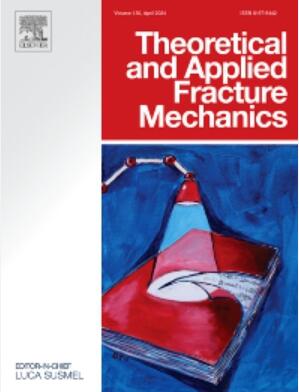主应力轴旋转效应对原位应力下爆破诱发裂纹扩展的影响机制
IF 5
2区 工程技术
Q1 ENGINEERING, MECHANICAL
引用次数: 0
摘要
原位应力在控制爆破引起的裂纹的扩展速度和轨迹方面起着举足轻重的作用。以往的研究主要侧重于此类裂纹扩展形态的定性分析,但忽略了静-动耦合加载下的主应力轴旋转效应。因此,爆破诱导裂纹扩展的力学机理尚未被弄清。本研究采用实验室试验、理论分析和数值模拟相结合的方法,探讨了原位应力下主应力轴旋转效应对爆破诱发裂纹扩展的影响机理。结果表明,静水压力不会改变爆破诱导裂纹的扩展轨迹,但较高的静水压力会抑制其扩展速度和长度。相反,偏差应力会改变爆破诱发裂纹的扩展轨迹,较高的偏差应力会使爆破诱发裂纹更容易向最大加载应力方向偏转。此外,在原位应力作用下,爆破诱发裂纹的扩展在不同阶段表现出不同的特征。在爆炸源附近的区域,动应力占主导地位,质量点的最大主应力分布在径向,爆炸诱发的裂缝主要沿径向扩展。相反,在远离爆破源的区域,静载荷占主导地位,质量点的最大应力方向变为最大加载应力方向,爆破引起的裂缝从径向偏转到最大加载应力方向。因此,在原位应力作用下,爆炸诱发的裂缝扩展是一个动态过程,在这个过程中,动应力和静应力争夺裂缝的萌发,应力值和主应力方向的变化被认为是爆炸诱发裂缝偏转的主要原因。本文章由计算机程序翻译,如有差异,请以英文原文为准。
Influence mechanism of the principal stress axis rotation effect on the propagation of blast-induced cracks under in-situ stress
In-situ stress plays a pivotal role in controlling both the propagation speed and trajectory of blast-induced cracks. Previous studies have primarily placed emphasis on the qualitative analysis of the propagation morphology of such cracks, but the principal stress axis rotation effect under static-dynamic coupling loading was ignored. Consequently, the mechanical mechanism of the propagation of blast-induced cracks has not been figured out yet. In this study, a combination of laboratory tests, theoretical analysis, and numerical simulations was employed to explore the influence mechanism of the principal stress axis rotation effect on the propagation of blast-induced cracks under in-situ stress. The results suggest that the hydrostatic pressure does not change the propagation trajectory of blast-induced cracks, but a higher hydrostatic pressure will inhibit both their propagation speed and length. In contrast, the deviatoric stress can change the propagation trajectory of blast-induced cracks, and a higher deviatoric stress makes it easier for blast-induced cracks to deflect to the maximum loading stress direction. Besides, the propagation of blast-induced cracks exhibits different features in different stages under in-situ stress. In the zone near the blast source, the dynamic stress is dominant; the maximum principal stress of the mass points is distributed in the radial direction; and blast-induced cracks expand mainly along the radial direction. On the contrary, in the zone far from the blast source, the static load is dominant; the maximum stress direction of the mass point alters to the maximum loading stress direction; and blast-induced cracks deflect from the radial direction to the maximum loading stress direction. Therefore, the propagation of blast-induced cracks under in-situ stress is a dynamic process in which dynamic and static stresses compete for crack initiation, and the changes in both stress value and principal stress direction are identified as the main reasons for the deflection of blast-induced cracks.
求助全文
通过发布文献求助,成功后即可免费获取论文全文。
去求助
来源期刊

Theoretical and Applied Fracture Mechanics
工程技术-工程:机械
CiteScore
8.40
自引率
18.90%
发文量
435
审稿时长
37 days
期刊介绍:
Theoretical and Applied Fracture Mechanics'' aims & scopes have been re-designed to cover both the theoretical, applied, and numerical aspects associated with those cracking related phenomena taking place, at a micro-, meso-, and macroscopic level, in materials/components/structures of any kind.
The journal aims to cover the cracking/mechanical behaviour of materials/components/structures in those situations involving both time-independent and time-dependent system of external forces/moments (such as, for instance, quasi-static, impulsive, impact, blasting, creep, contact, and fatigue loading). Since, under the above circumstances, the mechanical behaviour of cracked materials/components/structures is also affected by the environmental conditions, the journal would consider also those theoretical/experimental research works investigating the effect of external variables such as, for instance, the effect of corrosive environments as well as of high/low-temperature.
 求助内容:
求助内容: 应助结果提醒方式:
应助结果提醒方式:


